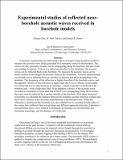Experimental studies of reflected nearborehole acoustic waves received in borehole models
Author(s)
Zhu, Zhenya; Toksoz, M. Nafi; Burns, Daniel R.
DownloadZhu_2008_final.pdf (2.736Mb)
Other Contributors
Massachusetts Institute of Technology. Earth Resources Laboratory
Metadata
Show full item recordAbstract
Laboratory experiments are performed with an isotropic Lucite borehole model to
measure the acoustic wave fields generated by a monopole source in the borehole. The
source not only generates acoustic waves propagating along the borehole, but also in the
surrounding formation. If there is a reflection interface in the formation, the acoustic
waves can be reflected back to the borehole. We measure the acoustic waves on the
model surface to investigate the acoustic fields in the formation. Acoustic measurements
record both waves reflected from an interface or fracture and those propagating in the
borehole. The frequency of the reflection is higher than that of the borehole waves, and
the apparent velocity of the reflection is higher than the P-wave velocity. In this paper,
we extract the waves reflected from an interface—which is parallel or declined to the
borehole axis—with a high-pass filter. If the apparent velocity of the acoustic wave
recorded in a borehole is faster than that of the P-wave propagating along the borehole,
the wave must be reflected by a surface outside of the borehole. With these measured
waveforms we calculate the distance between the borehole and the reflection surface and
the P-wave velocity in the direction perpendicular to the borehole axis. When the
reflection is declined to the borehole axis, the reflected waves recorded at both sides of
the source have different first-arrival-times and different apparent velocities. Laboratory
measurements show a new method to determine an interface out of a borehole, the
formation anisotropy, and the distance of a reflection.
Date issued
2008Publisher
Massachusetts Institute of Technology. Earth Resources Laboratory
Series/Report no.
Earth Resources Laboratory Industry Consortia Annual Report;2008-10